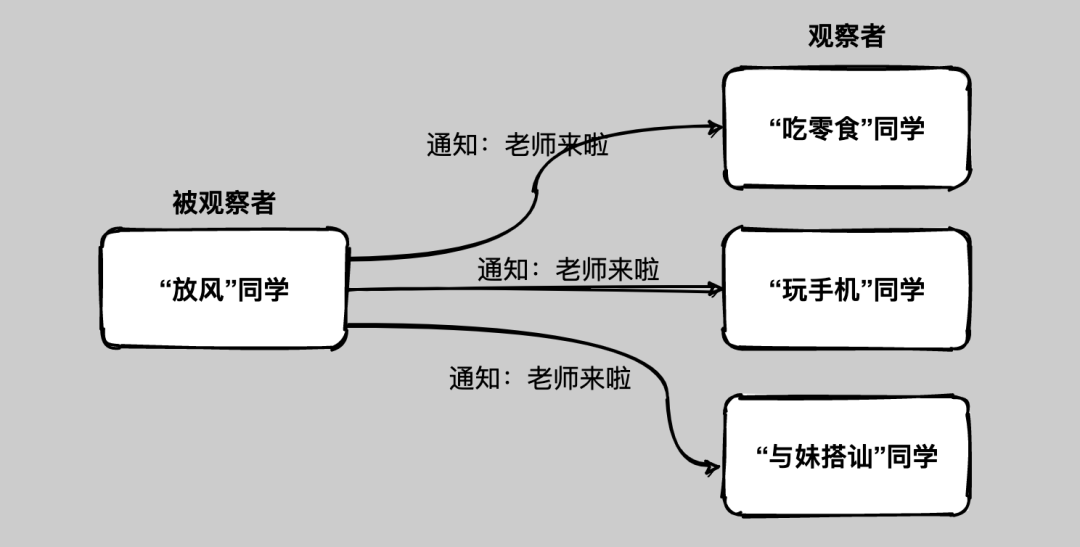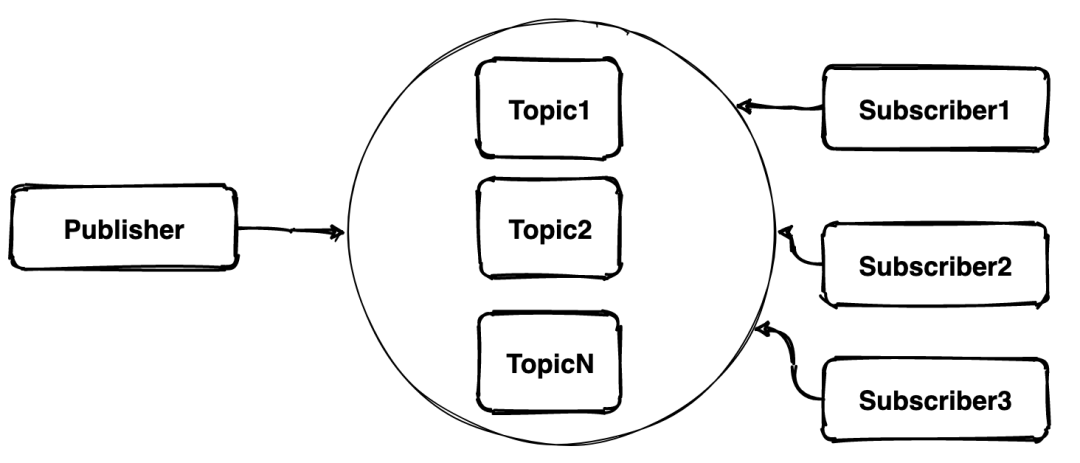
那你说说观察者模式和发布订阅模式的区别?
我脑海立刻闪现《Head First设计模式》里面讲的:
Publishers + Subscribers = Observer Pattern,问这么简单的问题难道是看不起我吗。
我内心无比激动,嘴角露出胜利者的微笑:亲爱的架构师,我之前看过一本书《Head First 设计模式》,这里面讲的观察者模式和发布订阅模式是等同关系的,它们是一回事。
架构师也笑了:不,它们不一样。
此刻我慌了,双手有点轻微颤抖,我哪里错了,它们明明是相等的。
观察者模式
观察者模式一般有观察者和被观察者。举个例子:大家在学校上自习的时候,等老师走了有些人会玩手机、吃零食、交头接耳找隔壁妹妹聊天,但是被老师发现可就不好了,所以大家想了一个招,让坐在最后排的同学帮忙“放风”,老师一来就给大家一个手势通知大家,大家就继续装好好学生(哈嘿)。

这其实就是一个典型的观察者模式,“放风”的同学是被观察者,玩手机、吃零食的同学是观察者,大家都在观察“放风”同学的手势,一旦老师来了,被观察者就会通知大家。
好了,让我们看看 UML 建模是如何定义的。
观察者模式定义对象间一种一对多的依赖关系,使得每当一个对象改变状态,则所有依赖于它的对象都会得到通知并自动更新。
UML结构图如下:

Subject类是主题,它把所有对观察者对象的引用文件存在了一个集合里,每个主题都可以有任何数量的观察者。它是一个抽象主题,提供了一个可以增加和删除观察者对象的接口。
Observer类
ConcreteSubject类是具体主题,将有关状态存入具体观察者对象,在具体主题内部状态改变时,给所有登记过的观察者发出通知。
ConcreteObserver是具体观察者,实现抽象观察者角色所要求的更新接口,以便使本身的状态与主题的状态相协同。
发布订阅模式
举个生活中的例子,比如我们想要订阅一份国家地理杂志,一般需要我们先向邮局申请(付钱),告诉邮局我要订阅这份杂志,苦等数日杂志终于印刷好了,这个时候我们不会直接跑到印刷厂里去,而是等印刷厂将杂志送给邮局,然后邮局才会慢吞吞地将杂志送到家(推模式),如果你实在等不及了跑到邮局直接取杂志,恭喜你学会了“拉模式”。

用专业术语来解释发布订阅模式:
订阅者把自己想订阅的事件注册到调度中心,当该事件触发时候,发布者发布该事件到调度中心(顺带上下文),由调度中心统一调度订阅者注册到调度中心的处理代码。

在发布订阅模式里发布者并不会直接通知订阅者,换句话说发布者和订阅者彼此互不感知。
那发布者和订阅者如何交流呢?答案是通过中间的调度中心。
- 发布者将消息发送给调度中心,告诉它你帮我把消息放到 Topic1中。
- 订阅者告诉调度中心,我需要订阅 topic1,你帮我留意一下。
- 当有消息来了,订阅者可以采取拉模式或者推模式来获取消息。
有态度的总结
话不多说,先上一张图:

从表面上看:
- 观察者模式里只有两个角色:
观察者和被观察者。 - 发布订阅模式里有三种角色:
发布者、订阅者、调度器(第三者)。
往更深层次讲:
- 观察者和被观察者是
松耦合的关系。 - 发布者和订阅者则完全
不存在耦合。
从使用层面上讲:
- 观察者模式经常用于
单个应用内部。 - 发布订阅模式更多是一种
跨应用的模式(cross-application pattern),比如我们常用的消息中间件Kafka 等。
综上:观察者模式和发布订阅模式本质上都有发布订阅的思想,但是又有一定的区别,所以我们不能将二者完全等同起来。
https://mp.weixin.qq.com/s/P04cJZKdvo8M5X-MjQ58Fw
什么是ApplicationContext?
它是Spring的核心,Context我们通常解释为上下文环境,但是理解成容器会更好些。
ApplicationContext则是应用的容器。
Spring把Bean(object)放在容器中,需要用就通过get方法取出来。
ApplicationEvent
是个抽象类,里面只有一个构造函数和一个长整型的timestamp。
ApplicationListener
是一个接口,里面只有一个onApplicationEvent方法。
所以自己的类在实现该接口的时候,要实装该方法。
如果在上下文中部署一个实现了ApplicationListener接口的bean,
那么每当在一个ApplicationEvent发布到 ApplicationContext时,
这个bean得到通知。其实这就是标准的Oberver设计模式。
一个Demo:
package com; import org.springframework.context.ApplicationEvent; /** * Created by MyWorld on 2016/7/31. */ public class DemoEvent extends ApplicationEvent{ public DemoEvent(Object source) { super(source); } }
package com; import org.springframework.context.ApplicationListener; import org.springframework.stereotype.Component; /** * Created by MyWorld on 2016/7/31. */ @Component public class DemoObserver1 implements ApplicationListener<DemoEvent> { @Override public void onApplicationEvent(DemoEvent demoEvent) { System.out.println(this.getClass().getCanonicalName() + " receive: " + demoEvent.getSource()); } }
package com; import org.springframework.context.ApplicationListener; import org.springframework.stereotype.Component; /** * Created by MyWorld on 2016/7/31. */ @Component public class DemoObserver2 implements ApplicationListener<DemoEvent> { @Override public void onApplicationEvent(DemoEvent demoEvent) { System.out.println(this.getClass().getCanonicalName() + " receive: " + demoEvent.getSource()); } }
package com; import org.springframework.context.ApplicationEventPublisher; import org.springframework.context.ApplicationEventPublisherAware; import org.springframework.stereotype.Component; /** * Created by MyWorld on 2016/7/31. */ @Component public class DemoSubject implements ApplicationEventPublisherAware { private ApplicationEventPublisher eventPublisher; @Override public void setApplicationEventPublisher(ApplicationEventPublisher applicationEventPublisher) { this.eventPublisher = applicationEventPublisher; } public void publish() { eventPublisher.publishEvent(new DemoEvent("Hello world!")); } }
测试类:
package com; import com.DemoConfig; import com.DemoSubject; import org.junit.Test; import org.junit.runner.RunWith; import org.springframework.beans.factory.annotation.Autowired; import org.springframework.test.context.ContextConfiguration; import org.springframework.test.context.junit4.SpringJUnit4ClassRunner; /** * Created by MyWorld on 2016/7/31. */ @RunWith(SpringJUnit4ClassRunner.class) @ContextConfiguration(classes = {DemoConfig.class}) public class DemoSubjectTest { @Autowired private DemoSubject demoSubject; @Test public void testPublish() throws Exception { demoSubject.publish(); } }
执行结果:
"C:\Program Files\Java\jdk1.8.0_65\bin\java" -ea -Didea.launcher.port=7535 "-Didea.launcher.bin.path=D:\Program Files\JetBrains\IntelliJ IDEA 14.1.6\bin" -Dfile.encoding=GBK -classpath "D:\Program Files\JetBrains\IntelliJ IDEA 14.1.6\lib\idea_rt.jar;D:\Program Files\JetBrains\IntelliJ IDEA 14.1.6\plugins\junit\lib\junit-rt.jar;C:\Program Files\Java\jdk1.8.0_65\jre\lib\charsets.jar;C:\Program Files\Java\jdk1.8.0_65\jre\lib\deploy.jar;C:\Program Files\Java\jdk1.8.0_65\jre\lib\javaws.jar;C:\Program Files\Java\jdk1.8.0_65\jre\lib\jce.jar;C:\Program Files\Java\jdk1.8.0_65\jre\lib\jfr.jar;C:\Program Files\Java\jdk1.8.0_65\jre\lib\jfxswt.jar;C:\Program Files\Java\jdk1.8.0_65\jre\lib\jsse.jar;C:\Program Files\Java\jdk1.8.0_65\jre\lib\management-agent.jar;C:\Program Files\Java\jdk1.8.0_65\jre\lib\plugin.jar;C:\Program Files\Java\jdk1.8.0_65\jre\lib\resources.jar;C:\Program Files\Java\jdk1.8.0_65\jre\lib\rt.jar;C:\Program Files\Java\jdk1.8.0_65\jre\lib\ext\access-bridge.jar;C:\Program Files\Java\jdk1.8.0_65\jre\lib\ext\cldrdata.jar;C:\Program Files\Java\jdk1.8.0_65\jre\lib\ext\dnsns.jar;C:\Program Files\Java\jdk1.8.0_65\jre\lib\ext\jaccess.jar;C:\Program Files\Java\jdk1.8.0_65\jre\lib\ext\jfxrt.jar;C:\Program Files\Java\jdk1.8.0_65\jre\lib\ext\localedata.jar;C:\Program Files\Java\jdk1.8.0_65\jre\lib\ext\nashorn.jar;C:\Program Files\Java\jdk1.8.0_65\jre\lib\ext\sunec.jar;C:\Program Files\Java\jdk1.8.0_65\jre\lib\ext\sunjce_provider.jar;C:\Program Files\Java\jdk1.8.0_65\jre\lib\ext\sunmscapi.jar;C:\Program Files\Java\jdk1.8.0_65\jre\lib\ext\sunpkcs11.jar;C:\Program Files\Java\jdk1.8.0_65\jre\lib\ext\zipfs.jar;D:\source\git\EventDemo\target\test-classes;D:\source\git\EventDemo\target\classes;G:\java\repository\org\springframework\spring-context\4.1.6.RELEASE\spring-context-4.1.6.RELEASE.jar;G:\java\repository\org\springframework\spring-aop\4.1.6.RELEASE\spring-aop-4.1.6.RELEASE.jar;G:\java\repository\aopalliance\aopalliance\1.0\aopalliance-1.0.jar;G:\java\repository\org\springframework\spring-beans\4.1.6.RELEASE\spring-beans-4.1.6.RELEASE.jar;G:\java\repository\org\springframework\spring-core\4.1.6.RELEASE\spring-core-4.1.6.RELEASE.jar;G:\java\repository\commons-logging\commons-logging\1.2\commons-logging-1.2.jar;G:\java\repository\org\springframework\spring-expression\4.1.6.RELEASE\spring-expression-4.1.6.RELEASE.jar;G:\java\repository\org\springframework\spring-test\4.1.6.RELEASE\spring-test-4.1.6.RELEASE.jar;G:\java\repository\junit\junit\4.12\junit-4.12.jar;G:\java\repository\org\hamcrest\hamcrest-core\1.3\hamcrest-core-1.3.jar" com.intellij.rt.execution.application.AppMain com.intellij.rt.execution.junit.JUnitStarter -ideVersion5 com.DemoSubjectTest 七月 31, 2016 1:50:40 下午 org.springframework.test.context.support.DefaultTestContextBootstrapper getDefaultTestExecutionListenerClassNames 信息: Loaded default TestExecutionListener class names from location [META-INF/spring.factories]: [org.springframework.test.context.web.ServletTestExecutionListener, org.springframework.test.context.support.DependencyInjectionTestExecutionListener, org.springframework.test.context.support.DirtiesContextTestExecutionListener, org.springframework.test.context.transaction.TransactionalTestExecutionListener, org.springframework.test.context.jdbc.SqlScriptsTestExecutionListener] 七月 31, 2016 1:50:40 下午 org.springframework.test.context.support.DefaultTestContextBootstrapper instantiateListeners 信息: Could not instantiate TestExecutionListener [org.springframework.test.context.jdbc.SqlScriptsTestExecutionListener]. Specify custom listener classes or make the default listener classes (and their required dependencies) available. Offending class: [org/springframework/transaction/interceptor/TransactionAttribute] 七月 31, 2016 1:50:40 下午 org.springframework.test.context.support.DefaultTestContextBootstrapper instantiateListeners 信息: Could not instantiate TestExecutionListener [org.springframework.test.context.transaction.TransactionalTestExecutionListener]. Specify custom listener classes or make the default listener classes (and their required dependencies) available. Offending class: [org/springframework/transaction/interceptor/TransactionAttributeSource] 七月 31, 2016 1:50:40 下午 org.springframework.test.context.support.DefaultTestContextBootstrapper instantiateListeners 信息: Could not instantiate TestExecutionListener [org.springframework.test.context.web.ServletTestExecutionListener]. Specify custom listener classes or make the default listener classes (and their required dependencies) available. Offending class: [javax/servlet/ServletContext] 七月 31, 2016 1:50:40 下午 org.springframework.test.context.support.DefaultTestContextBootstrapper getTestExecutionListeners 信息: Using TestExecutionListeners: [org.springframework.test.context.support.DependencyInjectionTestExecutionListener@17246de, org.springframework.test.context.support.DirtiesContextTestExecutionListener@f67ac7] 七月 31, 2016 1:50:40 下午 org.springframework.context.support.GenericApplicationContext prepareRefresh 信息: Refreshing org.springframework.context.support.GenericApplicationContext@1b6a447: startup date [Sun Jul 31 13:50:40 CST 2016]; root of context hierarchy com.DemoObserver1 receive: Hello world! com.DemoObserver2 receive: Hello world! Process finished with exit code 0
代码:https://github.com/helloworldtang/EventDemo.git
首先,什么是观察者模式:多个观察者去监听主题,当主题发生变化的时候,主题会通知所有的观察者。
盗用网上的一个图:
从上图的结构可以看出,主题维护了一个观察者类型的链表,每当主题变化的时候,就会循环调用各个观察者的对应方法(这就是通知)。
在观察者模式中,又分为 推模型 和 拉模型。
- 推模型:主题向观察者推送详细信息。
- 拉模型:主题把自身作为一个参数发送给观察者,观察者需要什么信息,那么就 主题.getXX() 。
Java中的观察者模式
再来看看 Java中的观察者模式,最后再提一下 个人在 SpringBoot 中对于观察者模式的实际使用。
Java 提供了 Observer接口(观察者接口) 和 Observable 接口(被观察者接口 / 主题接口)。源码如下:
Observable 接口(被观察者接口 / 主题接口):
public class Observable { private boolean changed = false; private Vector<Observer> obs; public Observable() { obs = new Vector<>(); } public synchronized void addObserver(Observer o) { if (o == null) throw new NullPointerException(); if (!obs.contains(o)) { obs.addElement(o); } } public synchronized void deleteObserver(Observer o) { obs.removeElement(o); } public void notifyObservers() { notifyObservers(null); } public void notifyObservers(Object arg) { Object[] arrLocal; synchronized (this) { if (!changed) return; arrLocal = obs.toArray(); · clearChanged(); } for (int i = arrLocal.length-1; i>=0; i--) ((Observer)arrLocal[i]).update(this, arg); } public synchronized void deleteObservers() { obs.removeAllElements(); } protected synchronized void setChanged() { changed = true; } protected synchronized void clearChanged() { changed = false; } public synchronized boolean hasChanged() { return changed; } public synchronized int countObservers() { return obs.size(); } }
如上代码:通过 Vector 维护一个 观察者类型的数组。通过调用 notifyObeservers(Object arg) 方法 来通过观察者。在实现中,也是通过for 循环 通知。
Ps:注意:从代码上看,需要先设changed。
Observer接口(观察者接口):
public interface Observer { void update(Observable o, Object arg); }
这两个参数的含义为:
* @param o the observable object.
* @param arg an argument passed to the <code>notifyObservers</code>
所以,此时即实现了 推模型,也实现了 拉模型。如果我们使用,那么分别实现这两个接口即可。
SpringBoot事件机制对于观察者模式的运用
那么在个人的实际运用中,做的是一个记账的服务,让别人来调用。当然,可以让别人直接在他们的业务处理后面,例如购买了XX东西,马上就直接调用我的记账服务,但是这样其实是一个紧耦合,由于是两个不同的业务,所以紧耦合感觉不太好。那么 观察者模式就有利于解耦。
对于Spring Boot 的事件机制,同样离不开 这2个东西-主题,观察者。 但是 ,spring boot 把 之前所说的通知,包装成了一个 Event。下面分析这三者。
SpringBoot的主题
Spring boot 的主题 可以 由 ApplicationContext 来充当。ApplicaitonContext 继承于 ApplicationEventPublisher。ApplicaiotnEventPublisher 源码如下:
public interface ApplicationEventPublisher { /** * Notify all listeners registered with this application of an application * event. Events may be framework events (such as RequestHandledEvent) * or application-specific events. * @param event the event to publish * @see org.springframework.web.context.support.RequestHandledEvent */ void publishEvent(ApplicationEvent event); }
其实该接口就是我们 发布事件的接口。
SpringBoot 的观察者
Spring Boot 的观察者由 ApplicationListener 来进行充当。源码如下:
public interface ApplicationListener<E extends ApplicationEvent> extends EventListener { /** * Handle an application event. * @param event the event to respond to */ void onApplicationEvent(E event); }
可以看到, onApplicaiton(E event) 方法即 上文所说的 update 方法。
SpringBoot的Event
自定义事件 继承ApplicationEvent抽象类
是Subject和Object传递消息的介质。因为这个类型的特殊性、唯一性,可以作为标识的依据。
就像Button按钮的点击事件、Move事件
上文所说的 主题 和 观察者 都有体现,传输的消息 Spring Boot 使用了一个 ApplicationEvent 进行了封装,
源码如下:
public abstract class ApplicationEvent extends EventObject { /** use serialVersionUID from Spring 1.2 for interoperability */ private static final long serialVersionUID = 7099057708183571937L; /** System time when the event happened */ private final long timestamp; public ApplicationEvent(Object source) { super(source); this.timestamp = System.currentTimeMillis(); } public final long getTimestamp() { return this.timestamp; } }
EventObject 源码:
public class EventObject implements java.io.Serializable { private static final long serialVersionUID = 5516075349620653480L; /** * The object on which the Event initially occurred. */ protected transient Object source; public EventObject(Object source) { if (source == null) throw new IllegalArgumentException("null source"); this.source = source; } public Object getSource() { return source; } public String toString() { return getClass().getName() + "[source=" + source + "]"; } }
最后,我们程序中只需要 注入ApplicaitonContext (Subject)发送消息publishEvent;
实现 ApplicationListener 接口的Observer进行相应的处理即可。
要注册事件监听器,我们只需要把它配置成一个Bean即可,ApplicationContext容器会自动将其注册。
总结
观察者模式实质是 有两个 东西:
- 一个是 主题
- 一个是观察者
主题中维护了 观察者列表的引用。当主题有变更的时候,循环调用观察者,通知其做相应的处理。另外,不论是 Java,还是 Spring ,都是利用这个原理,只是有不同的类充当 主题 和 观察者。
另外,观察者模式有一个好处:解耦。
http://blog.csdn.net/allen215902/article/details/50747438
通过Application. publishEvent方法,我们可以将事件通知系统内所有的ApplicationListener。
ApplicationContext容器提供了容器内部事件发布功能,是继承自JavaSE标准自定义事件类而实现的。
JavaSE标准自定义事件结构不在此详细描述,一张图很直观的描述清楚:

EventObject,为JavaSE提供的事件类型基类,任何自定义的事件都继承自该类,例如上图中右侧灰色的各个事件。Spring中提供了该接口的子类ApplicationEvent。
EventListener为JavaSE提供的事件监听者接口(Observer),任何自定义的事件监听者都实现了该接口,如上图左侧的各个事件监听者。
Spring中提供了该接口的子类ApplicationListener接口。
JavaSE中未提供事件发布者这一角色类,由各个应用程序自行实现事件发布者这一角色。Spring中提供了ApplicationEventPublisher接口作为事件发布者,并且ApplicationContext(Subject)实现了这个接口,担当起了事件发布者这一角色。
但ApplicationContext在具体实现上有所差异,Spring提供了ApplicationEventMulticaster接口,负责管理ApplicationListener和发布ApplicationEvent。ApplicationContext会把相应的事件相关工作委派给ApplicationEventMulticaster接口实现类来做。
类图如下所示:
事件发布时序图如下:

Spring中提供一些Aware相关的接口,BeanFactoryAware、 ApplicationContextAware、ResourceLoaderAware、ServletContextAware等等,其中最常用到的是ApplicationContextAware。
实现ApplicationContextAware的Bean,在Bean被初始后,将会被注入ApplicationContext的实例。
ApplicationContextAware提供了publishEvent()方法,实现Observer(观察者)设计模式的事件传播机,提供了针对Bean的事件传播功能。
通过Application.publishEvent方法,我们可以将事件通知系统内所有的ApplicationListener。
Spring事件处理一般过程:
◆定义Event类(Subject和Observer传递消息的介质),继承org.springframework.context.ApplicationEvent。
◆编写发布事件类Publisher(Subject),实现org.springframework.context.ApplicationContextAware接口。
◆覆盖方法setApplicationContext(ApplicationContext applicationContext)和发布方法publish(Object obj)。
◆定义时间监听类EventListener(Observer),实现ApplicationListener接口,实现方法onApplicationEvent(ApplicationEvent event)。
import org.springframework.context.ApplicationEventPublisher; import org.springframework.context.ApplicationEventPublisherAware; /** * * @author zq * */ public class HelloWorld implements ApplicationEventPublisherAware{ private String word; private ApplicationEventPublisher tradeEventPublisher; public void setWord(String w){ this.word = w; } public void say(){ System.out.println("say : "+ this.word); //construct a TradeEvent instance and publish it TradeEvent tradeEvent = new TradeEvent(new String("tradeEvent")); this.tradeEventPublisher.publishEvent(tradeEvent); } @Override public void setApplicationEventPublisher( ApplicationEventPublisher applicationEventPublisher) { // TODO Auto-generated method stub this.tradeEventPublisher = applicationEventPublisher; } }
2.接受事件
import org.springframework.context.ApplicationEvent; import org.springframework.context.ApplicationListener; import org.springframework.context.event.ContextStartedEvent; public class TradeContextListener implements ApplicationListener{ @Override public void onApplicationEvent(ApplicationEvent e) { System.out.println(e.getClass().toString()); // TODO Auto-generated method stub if (e instanceof ContextStartedEvent){ System.out.println("it was contextStartedEvent"); } if (e instanceof TradeEvent){ System.out.println(e.getSource()); } } }
3配置文件
<?xml version="1.0" encoding="utf-8"?> <!DOCTYPE beans PUBLIC "-//SPRING//DTD BEAN//EN" "http://www.springframework.org/dtd/spring-beans.dtd"> <beans> <bean name="helloWorld" class="study.HelloWorld"> <property name="word" value="hello world"/> </bean> <bean id="tradeContextListener" class="study.TradeContextListener"/> </beans>
4.测试代码
import org.springframework.context.ApplicationContext; import org.springframework.context.support.ClassPathXmlApplicationContext; import study.HelloWorld; public class TestHelloWorld { /** * @param args */ public static void main(String[] args) { // TODO Auto-generated method stub ApplicationContext applicationContext = new ClassPathXmlApplicationContext("study-context.xml"); HelloWorld bean = (HelloWorld)applicationContext.getBean("helloWorld"); bean.say(); } }
1) ContextRefreshedEvent:当ApplicationContext初始化或者刷新时触发该事件。
2) ContextClosedEvent:当ApplicationContext被关闭时触发该事件。容器被关闭时,其管理的所有单例Bean都被销毁。
3) RequestHandleEvent:在Web应用中,当一个http请求(request)结束触发该事件。
ContestStartedEvent:Spring2.5新增的事件,当容器调用ConfigurableApplicationContext的Start()方法开始/重新开始容器时触发该事件。
5) ContestStopedEvent:Spring2.5新增的事件,当容器调用ConfigurableApplicationContext的Stop()方法停止容器时触发该事件。
下面通过一个例子展示如何处理Spring内定的事件(例程3.8)。创建一个Java工程,添加Spring开发能力后,新建ioc.test包。在包中新建ApplicationEventListener类,实现ApplicationListener接口,在onApplicationEvent()方法中添加事件处理代码,如下:
//Import省略 public class ApplicationEventListenerimplements ApplicationListener { public void onApplicationEvent(ApplicationEvent event) { //如果是容器刷新事件 if(event instanceof ContextClosedEvent ){ System.out.println(event.getClass().getSimpleName()+" 事件已发生!"); }else if(event instanceof ContextRefreshedEvent ){//如果是容器关闭事件 System.out.println(event.getClass().getSimpleName()+" 事件已发生!"); }else if(event instanceof ContextStartedEvent ){ System.out.println(event.getClass().getSimpleName()+" 事件已发生!"); }else if(event instanceof ContextStoppedEvent){ System.out.println(event.getClass().getSimpleName()+" 事件已发生!"); }else{ System.out.println("有其它事件发生:"+event.getClass().getName()); } } }
在Spring配置文件中定义一个Bean,类为ApplicationEventListener,代码如下:
<?xml version="1.0" encoding="UTF-8"?> <beans………… <bean id="ApplicationEventListener" class="ioc.test.ApplicationEventListener"/> </beans>
添加含有主方法的TesMain类,在主方法中,调用容器的相应方法,触发Spring内定事件,代码如下:
//import省略 public class TesMain { publicstaticvoid main(String[] args) { AbstractApplicationContext ac=new ClassPathXmlApplicationContext("applicationContext.xml"); // ac.refresh();//触发ContextRefreshedEvent事件 ac.start();//触发ContextStartedEvent事件 ac.stop(); //触发ContextStoppedEvent事件 ac.close();//关闭容器,触发ContextClosedEvent事件 } }
运行主类,控制台输出如下:
从例子中可以知道,要注册事件监听器,我们只需要把它配置成一个Bean即可,ApplicationContext容器会自动将其注册。
http://blog.csdn.net/it_man/article/details/8440737